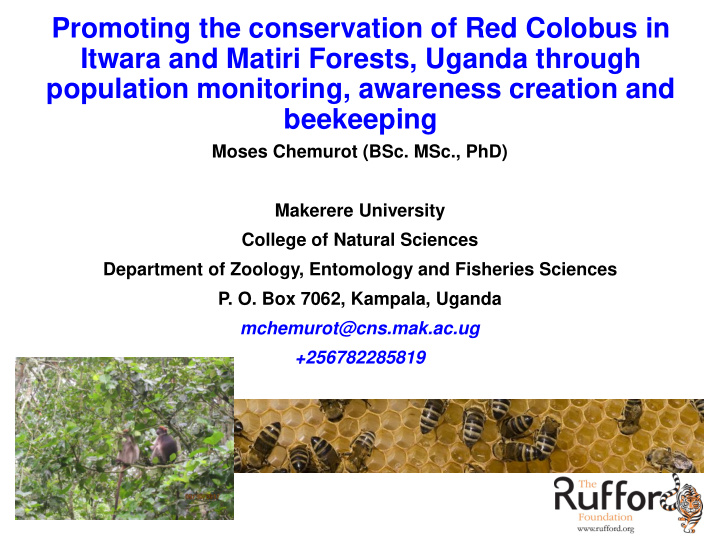



Promoting the conservation of Red Colobus in Itwara and Matiri Forests, Uganda through population monitoring, awareness creation and beekeeping Moses Chemurot (BSc. MSc., PhD) Makerere University College of Natural Sciences Department of Zoology, Entomology and Fisheries Sciences P. O. Box 7062, Kampala, Uganda mchemurot@cns.mak.ac.ug +256782285819
Outline of the talk 1. Introduction 2. What we have done 3. Conclusions 4. Acknowledgements
Meet the team Moses Chemurot 1 , Jennifer Wanyingi 2 , Sam Mugume 3 , Gilbert Isabirye- Basuta 1 , Ubaldo Rutazaana 1 , Chris Bakuneeta 1 , Grace Karogo 4 , Deborah Baranga 1 , Adalbert Aine-Omucunguzi 5 , Furuichi Takeshi 6 1 Department of Zoology, Entomology and Fisheries Sciences, School of Biosciences, College of Natural Sciences, Makerere University, P.O. Box 7062 Kampala, Uganda 2 Department of Wildlife, University of Eldoret, Kenya 3 Kabarole District Local Government, P.O. Box 38, Fort Portal, Uganda 4 Biology Department, Faculty of Science, Mbarara University of Science and Technology, P. O. Box 1410 Mbarara, Uganda 5 African Institute for Capacity Development (AICAD), Uganda Country Office 6 Primate Research Institute, Kyoto University, Japan
Introduction Red colobus: Procolobus rufomitratus tephrosceles Threatened primate species
Distribution of red colobus across north central Africa (black shading; Ting 2008), with the red star highlighting Kibale National Park (KNP). (b) Uganda with the location of KNP in red (c) KNP
Introduction Red colobus distribution in Uganda • Kibale National Park • Matiri and Itwara Central Forest Reserves (Mugume et al. 2015) • Semliki National Park and Wildlife Reserve? Red colobus threats • Human activities • Chimpanzee hunting Need to protect isolated populations of Red colobus
Chimpanzee eating a monkey
Project Goal Promote Red Colobus conservation in Matiri and Itwara Central Forest Reserves in Uganda Population monitoring and habitat quality assessment Promoting Red Colobus conservation in schools and community Promoting environmentally friendly IGAs e.g. beekeeping
Why beekeeping Bees are a key component of agriculture worldover About 80% of Uganda’s population is involved in agriculture Beekeeping: source of household incomes, food & employment Annual pollination value: $ billion 0.49 from crops valued at $ 1.16 billion
Introduction Economics of beekeeping Economically, beekeeping is ranked 2nd or 3rd among livestock world wide Economic Livestock importance ($) CATTLE (meat, milk, skin) 331,407,538,000 Honeybees (products, pollination) 180,990,944,120 Pigs (meat) 173,423,160,000 Poultry (meat, eggs) 144,241,789,000 Sheep (meat,milk, wool, skin) 41,319,473,000 25,331,724,000 Goat (meat, milk, skin) Source: Jacobs et al. 2005
Beekeeping in Uganda Relatively low-cost & low labour intensive enterprise that does not require a lot of land Beekeeping can be practiced in unproductive lands Viable for people like women & youth who are least likely to access production factors
Beekeeping and C onservation Pollination of wild plants: food for wildlife Controlling elephant crop raiding Earnings from tourism: $ 979 million in 2013; largest foreign exchange earner Beekeeping important for sustainable development 12
What we have done Field work Field surveys Questionnaire administration Data analyses IPS Nairobi 2018 abstract Sharing the findings with stakeholders
Achievements Communities prefer Goat farming IGAs as adaptation strategies to conservation challenges
Factors considered by households when selecting livelihood adaptation strategies Communities consider most effectiveness, cost and profit of IGA
Cooperation of local authorities with communities in supporting adaptations to conservation challenges Communities say local authorities are not cooperative in supporting their adaptation to conservation challenges
Relative abundance (no. per km transect) of primates during the survey Forest Chimps Red Colobus Blue Monkey Black & White Red-tailed Baboons Itwara 8.6 0 4.2 27.2 21.7 1.3 Matiri 0 0 0 3.7 0 0 No record of Red colobus yet in the last 5 months; are they locally extinct?
Frequency of anthropogenic activities per km transect Anthropogenic activities Matiri Itwara Traps 1.7 3.3 Fuel wood sites 1.5 0.3 Pit-sawing sites 8.7 6.2 Relatively higher frequency of trapping sites for wildlife in Itwara
Fresh pit-sawing site in Itwara CFR
Blue dyker trapped in Itwara CFR
Synthesis Red colobus vulnerability to changes in the environment : Conceptual diagram, showing the range of variability of ‘‘Current Red colobus environment’’ parameters for anthropogenic pressures, climate change, pathogen intensity and chimpanzee hunting with a small portion of the environment situation ‘‘space’’ currently in the low mortality for Red colobus. ‘‘Future colobus environment’’ shows increases in extreme anthropogenic pressure, increased pathogen intensities, effects of climate change and chimpanzee hunting events associated with foreseen environmental changes, indicating increased risks of die-off for current populations.
Recommendations Identification of livelihood options for interventions to address conservation 1 . challenges MUST involve local communities for ownership Develop effective forest patrolling systems to control illegal activities 2 . Regular monitoring of threatened wildlife populations 3. Survey un-surveyed protected areas for Red Colobus 4 . Community awareness on Red Colobus is required 5.
Acknowledgements
Thank you for listening Our homes are getting destroyed ! Are we still safe? Am not sure! Well, how do we find out? Ugandan primate conversation
Recommend
More recommend